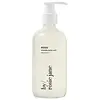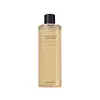What's inside
What's inside
 Key Ingredients
Key Ingredients

 Benefits
Benefits

 Concerns
Concerns

 Ingredients Side-by-side
Ingredients Side-by-side

Water
Skin ConditioningSodium C14-16 Olefin Sulfonate
CleansingDisodium Cocoamphodiacetate
CleansingCocamide Dipa
EmulsifyingGlycerin
HumectantSodium Chloride
MaskingCaprylyl Glycol
EmollientCitric Acid
BufferingHydroxypropyl Methylcellulose
Emulsion StabilisingAloe Barbadensis Leaf Juice
Skin ConditioningSodium Dehydroacetate
PreservativeTocopheryl Acetate
AntioxidantAlthaea Officinalis Root Extract
Skin ConditioningAvena Sativa Kernel Extract
AbrasiveCalendula Officinalis Flower Extract
MaskingCamellia Sinensis Extract
AntioxidantChamomilla Recutita Extract
Skin ConditioningLavandula Angustifolia Extract
Skin ConditioningPrunus Amygdalus Dulcis Fruit Extract
Skin ConditioningTrifolium Pratense Extract
Skin ConditioningCamellia Sinensis Leaf Extract
AntimicrobialGlycyrrhiza Glabra Root Extract
BleachingHedychium Spicatum Extract
Skin ConditioningOlea Europaea Leaf Extract
PerfumingPinus Pinaster Bark Extract
AntioxidantPunica Granatum Extract
AstringentRosmarinus Officinalis Leaf Extract
AntimicrobialTheobroma Cacao Extract
Skin ConditioningVitis Vinifera Seed Extract
AntimicrobialWater, Sodium C14-16 Olefin Sulfonate, Disodium Cocoamphodiacetate, Cocamide Dipa, Glycerin, Sodium Chloride, Caprylyl Glycol, Citric Acid, Hydroxypropyl Methylcellulose, Aloe Barbadensis Leaf Juice, Sodium Dehydroacetate, Tocopheryl Acetate, Althaea Officinalis Root Extract, Avena Sativa Kernel Extract, Calendula Officinalis Flower Extract, Camellia Sinensis Extract, Chamomilla Recutita Extract, Lavandula Angustifolia Extract, Prunus Amygdalus Dulcis Fruit Extract, Trifolium Pratense Extract, Camellia Sinensis Leaf Extract, Glycyrrhiza Glabra Root Extract, Hedychium Spicatum Extract, Olea Europaea Leaf Extract, Pinus Pinaster Bark Extract, Punica Granatum Extract, Rosmarinus Officinalis Leaf Extract, Theobroma Cacao Extract, Vitis Vinifera Seed Extract
Water
Skin ConditioningSodium Laureth Sulfate
CleansingDisodium Cocoamphodiacetate
CleansingCocamidopropyl Betaine
CleansingPropanediol
SolventP-Anisic Acid
MaskingCentella Asiatica Extract
CleansingHouttuynia Cordata Extract
Skin ConditioningScutellaria Baicalensis Root Extract
AstringentCamellia Sinensis Leaf Extract
AntimicrobialParfum
MaskingSalicylic Acid
MaskingOleth-20
CleansingCaprylyl Glycol
EmollientHydrolyzed Sclerotium Gum
HumectantCitric Acid
BufferingPolygonum Cuspidatum Root Extract
AntioxidantMelaleuca Alternifolia Leaf Oil
AntioxidantLavandula Angustifolia Oil
MaskingAsiaticoside
AntioxidantAsiatic Acid
Skin ConditioningMadecassic Acid
Skin ConditioningWater, Sodium Laureth Sulfate, Disodium Cocoamphodiacetate, Cocamidopropyl Betaine, Propanediol, P-Anisic Acid, Centella Asiatica Extract, Houttuynia Cordata Extract, Scutellaria Baicalensis Root Extract, Camellia Sinensis Leaf Extract, Parfum, Salicylic Acid, Oleth-20, Caprylyl Glycol, Hydrolyzed Sclerotium Gum, Citric Acid, Polygonum Cuspidatum Root Extract, Melaleuca Alternifolia Leaf Oil, Lavandula Angustifolia Oil, Asiaticoside, Asiatic Acid, Madecassic Acid
Ingredients Explained
These ingredients are found in both products.
Ingredients higher up in an ingredient list are typically present in a larger amount.
Camellia Sinensis Leaf Extract is derived from the leaves of the tea plant. Black tea, green tea, and oolong tea are all harvested from this plant.
This ingredient has many skin benefits:
This ingredient contains polyphenols, a strong antioxidant. Antioxidants help fight off molecules that damage skin cells.
On top of that, the antioxidants in green tea neutralize free-radicals from the sun. This gives the skin some extra UV protection, but should not replace sunscreen.
Many components of tea have anti-inflammatory properties.
Polyphenols and L-theanine help soothe the skin and reduce irritation. The caffeine in Camellia Sinensis Leaf Extract helps calm inflamed blood vessels.
Other compounds found in tea include: Vitamin Bs, linoleic acid, magnesium, calcium, iron, and zinc.
Research has shown both drinking Camellia Sinensis Leaf Tea and applying it to the skin can help boost skin elasticity and hydration. Studies also show using tea extract may reduce sebum, or oil, production.
Learn more about Camellia Sinensis Leaf ExtractCaprylyl Glycol is a humectant and emollient, meaning it attracts and preserves moisture.
It is a common ingredient in many products, especially those designed to hydrate skin. The primary benefits are retaining moisture, skin softening, and promoting a healthy skin barrier.
Though Caprylyl Glycol is an alcohol derived from fatty acids, it is not the kind that can dry out skin.
This ingredient is also used as a preservative to extend the life of products. It has slight antimicrobial properties.
Learn more about Caprylyl GlycolCitric Acid is an alpha hydroxy acid (AHA) naturally found in citrus fruits like oranges, lemons, and limes.
Like other AHAs, citric acid can exfoliate skin by breaking down the bonds that hold dead skin cells together. This helps reveal smoother and brighter skin underneath.
However, this exfoliating effect only happens at high concentrations (20%) which can be hard to find in cosmetic products.
Due to this, citric acid is usually included in small amounts as a pH adjuster. This helps keep products slightly more acidic and compatible with skin's natural pH.
In skincare formulas, citric acid can:
While it can provide some skin benefits, research shows lactic acid and glycolic acid are generally more effective and less irritating exfoliants.
Most citric acid used in skincare today is made by fermenting sugars (usually from molasses). This synthetic version is identical to the natural citrus form but easier to stabilize and use in formulations.
Read more about some other popular AHA's here:
Learn more about Citric AcidDisodium Cocoamphodiacetate is a surfactant and helps cleanse skin. It is created from the fatty acids of coconut oil.
Surfactants help rinse oil, dirt, and other pollutants easily from skin. It has a faint fruit-like scent.
Water. It's the most common cosmetic ingredient of all. You'll usually see it at the top of ingredient lists, meaning that it makes up the largest part of the product.
So why is it so popular? Water most often acts as a solvent - this means that it helps dissolve other ingredients into the formulation.
You'll also recognize water as that liquid we all need to stay alive. If you see this, drink a glass of water. Stay hydrated!
Learn more about Water